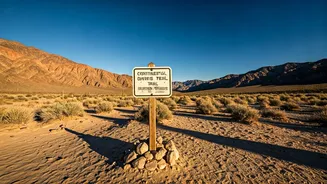Military Restrictions Emerge
Recent developments reveal that the military has imposed limitations on certain hikers attempting to access the Southern Terminus of the Continental Divide
Trail. These restrictions, though not specifically detailed in a given source, signal a shift in access policies for this segment of the popular trail. The reasons behind this decision remain less clear, as the source doesn't provide precise motivations. It is, however, essential for hikers and anyone interested in the trail to understand the scope of these changes. These restrictions could affect the planning and execution of CDT thru-hikes and shorter adventures, and understanding them is crucial. These restrictions highlight the dynamic nature of public land access and underscore the need for hikers to stay informed.
Understanding The Context
The Continental Divide Trail (CDT) is a lengthy, remarkable trail running the length of the United States. Spanning roughly 3,100 miles, it traverses five states and offers an experience of varying landscapes. Its popularity among long-distance hikers has grown. The trail is renowned for its remote and challenging terrain, appealing to those seeking an immersive wilderness experience. The Southern Terminus, typically a starting point for northbound hikers, is the focus of these newly implemented restrictions. Details on the specific location impacted, the types of restrictions, and the scope of these restrictions, such as who is affected, are yet unavailable from the source. The evolving access policies are, therefore, a key consideration for anyone considering hiking the CDT.
Impact On Hikers
The repercussions of restricted access to the Southern Terminus are varied and could create significant challenges for hikers. A primary concern is the potential disruption to established hiking plans. Many CDT hikers begin their journey at this very location, and any access restrictions necessitate changes to their strategies. Another impact would be on safety protocols. Changes to the usual access points may lead to hikers needing to adjust their resupply points, which, in turn, could affect the timing of their expeditions. Hikers must take into account how this would affect their ability to manage resources such as food and water. This is especially critical in remote stretches of the trail where reliable resupply options are limited. This might mean hikers have to seek alternate routes or adjust their start dates, making meticulous planning essential.
Possible Explanations, Insights
Without the source data providing an explanation for the military's actions, it's difficult to offer a definitive cause for this new restriction. However, the military may cite security concerns in the area, specifically regarding access to military installations or training grounds. Operational demands or environmental preservation considerations could also play a significant role. The military frequently balances public access with its specific requirements and strategic objectives. The terrain's delicate ecological balance may lead to such decisions. Therefore, understanding the military's rationale is important for hikers and trail organizations to facilitate dialogues and solutions. It's hoped that the explanation behind the restrictions, when it's publicly released, allows for transparency and allows for hikers to be well-informed.
Implications And Beyond
The restrictions at the Southern Terminus serve as a reminder of the evolving nature of public land access. This case underscores the complex balance between recreational use and other priorities, like national security, environmental conservation, and military operations. This prompts questions about the future of trail access across the U.S. and the potential impact of similar actions on other trails. Trail organizations, hikers, and authorities need to engage in ongoing communication to ensure everyone can navigate evolving policies. It highlights the importance of staying informed and advocating for open dialogue to address issues of public access. This also requires constant cooperation between trail users and land management agencies to secure the long-term sustainability of trails.














